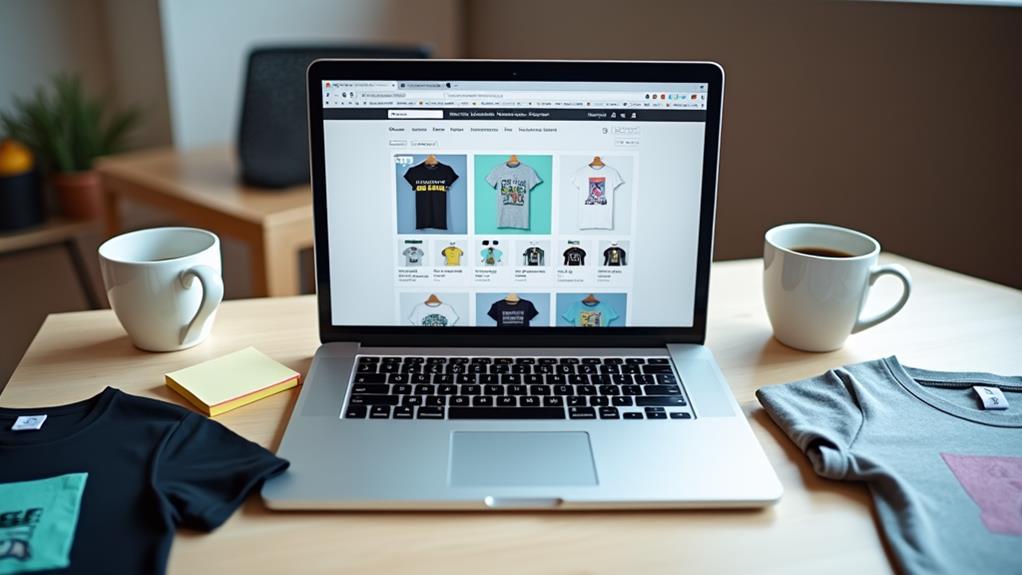
Starting a print-on-demand business in 2024 involves selecting a profitable niche, identifying trending products, and utilizing design tools like Printify or Printful for customization. Choose eco-friendly items like custom t-shirts, leverage platforms such as Google Trends and social media for market analysis, and integrate with eCommerce sites like Shopify. Employ data-driven marketing strategies on Instagram and through influencer partnerships, while monitoring key financial metrics for ideal pricing. Utilize Google Analytics to track performance and make data-informed adjustments. Continual customer feedback and adaptive goal-setting are critical for sustained growth. Gain further insights by exploring detailed aspects of this approach.
Key Takeaways
- Select a niche using tools like Google Trends and validate it through customer feedback for market fit.
- Research and choose trendy products, focusing on items like custom t-shirts and eco-friendly products.
- Use platforms like Printify and Printful to design unique products with tools like Adobe Illustrator and Canva.
- Set up an eCommerce store with seamless integration, intuitive layout, and robust payment gateways.
- Implement social media strategies, influencer partnerships, and SEO to market your products effectively.
Understanding Print on Demand
Understanding Print on Demand (POD) is vital for aspiring entrepreneurs in the eCommerce sector. POD is an innovative business model that allows companies to produce custom products such as apparel, accessories, home goods, and printed items like mugs and art prints without maintaining inventory. Orders are fulfilled only after a customer has made a purchase, operating on a pay-per-sale basis. This minimizes financial risk, making it particularly advantageous for new entrepreneurs and artists seeking to monetize their designs.
One of the primary POD benefits is the elimination of upfront inventory costs, which can greatly reduce initial capital requirements. Additionally, the model offers flexibility in product offerings and facilitates rapid testing of new designs, enabling businesses to quickly adapt to market trends and consumer preferences. This adaptability is underscored by the projected growth of the global POD market, expected to reach approximately $48.4 billion by 2032, highlighting the soaring demand for personalized products.
However, there are notable POD challenges. Entrepreneurs must navigate complexities such as ensuring high-quality printing, managing longer shipping times, and maintaining customer satisfaction. Effective supply chain management and strategic partnerships with reliable suppliers are essential to overcoming these hurdles and achieving success in this burgeoning market.
Choosing Your Niche
Selecting a specific niche is a fundamental step in launching a successful Print on Demand business, as it markedly reduces competition and enhances marketing effectiveness. Conducting thorough niche research using tools like Google Trends and social media can pinpoint profitable opportunities and current consumer interests. This data-driven approach guarantees that businesses can cater to their target audience effectively.
Passion-driven niches, such as fitness, pets, or hobbies, often foster higher customer loyalty due to the shared connection with the audience. Validating these niche ideas through feedback from potential customers can confirm market fit and profitability before product launch, mitigating risks and guaranteeing alignment with consumer demand.
Unique niches not only differentiate a brand but also build credibility and trust, which are vital for long-term success in the POD market. By focusing on a specific target audience, businesses can tailor their products and marketing strategies to meet the distinct needs and preferences of their customers.
| Niche Research Tools | Purpose |
|---|---|
| Google Trends | Identify profitable opportunities |
| Social Media | Monitor current consumer interests |
| Niche Type | Benefits |
| Passion-Driven | Higher customer loyalty |
| Unique Niches | Enhanced brand credibility |
This targeted approach is essential for establishing a strong foothold in the competitive POD landscape.
Selecting Products
When selecting products for your print-on-demand business, it is essential to focus on trendy items such as custom t-shirts, hoodies, and eco-friendly products, which have shown consistent demand according to trend analysis tools like Google Trends.
Utilizing design customization tools can further enhance product appeal by allowing for unique, personalized items that cater to niche markets and specific consumer interests. This strategy not only aligns with evolving consumer preferences but also positions your brand competitively in a saturated market.
Additionally, incorporating eco-friendly materials into your products can attract the growing segment of consumers who prioritize sustainability.
Identifying Trendy Items
Delving into the domain of Print on Demand (POD) necessitates a strategic approach to identifying trendy items that align with consumer preferences. Leveraging platforms like Amazon, eBay, and Etsy provides vital insights into popular items such as custom t-shirts, mugs, and phone cases. These platforms reveal trending colors and designs that resonate with a wide array of target demographics.
Utilizing Google Trends is essential for a data-driven analysis of search volume and seasonal demand for specific products. This tool can pinpoint rising popularity in certain product categories, enabling businesses to capitalize on market trends.
Social media platforms like Pinterest and Instagram are invaluable for uncovering the types of designs and products currently favored by users. Analyzing these platforms offers a glimpse into consumer preferences and trending aesthetics that can be leveraged to attract attention.
Eco-friendly products are another important area to take into account. With sustainability becoming increasingly important, offering items made from sustainable materials can attract environmentally conscious buyers.
Design Customization Tools
Harnessing the power of design customization tools is essential for any print-on-demand business aiming to offer unique and appealing products. Leading platforms such as Printify and Printful provide users with robust design software that facilitates the creation of customized items like t-shirts, mugs, and tote bags.
These tools typically feature an extensive array of templates, fonts, clipart options, and pre-made designs, allowing users to produce distinctive offerings without necessitating advanced graphic design skills. The user experience is greatly enhanced by these user-friendly design interfaces, which support direct uploads of high-resolution images and graphics.
This guarantees ideal print quality, a vital factor in maintaining customer satisfaction and reducing returns. Additionally, the ability to preview products through virtual mockups allows sellers to visualize their designs on actual items before committing to listings, thereby minimizing errors and enhancing product appeal.
Integrating these print-on-demand services with eCommerce platforms like Shopify streamlines the entire process from product selection to customization and order fulfillment. This seamless integration not only improves operational efficiency but also provides a cohesive and professional experience for both the seller and the end customer, underlining the significance of effective design customization tools in a successful print-on-demand business.
Creating Unique Designs
Utilizing graphic design tools such as Adobe Illustrator and Canva, businesses can craft high-resolution designs (300 dpi) essential for quality print outputs.
By researching trending styles on Pinterest and Instagram, entrepreneurs can generate design ideas that align with market preferences. Awareness of design trends and color palettes enhances the professionalism of designs, making them more appealing to potential customers.
Additionally, hiring freelance designers from platforms like Fiverr or Upwork can guarantee professional-quality designs, enabling business owners to allocate their time to other critical operations.
Drawing Design Inspiration
When starting a print on demand business, drawing design inspiration is a critical step that can greatly influence your venture's success. Leveraging current design trends and diverse inspiration sources can help you create unique, market-ready products that resonate with customers.
To effectively gather design inspiration, consider the following strategies:
- Explore Platforms: Use Pinterest and Dribbble to discover trending design ideas and gather inspiration that aligns with your target audience.
- Utilize Graphic Design Software: Employ tools like Adobe Illustrator, Photoshop, or Canva to craft high-quality, customized designs that have a professional look.
- Research Market Preferences: Investigate popular niches and customer preferences to tailor your designs, enhancing their appeal within your chosen market.
- Incorporate Eco-Friendly Themes: As sustainable products gain traction, integrating eco-friendly design elements can attract environmentally conscious consumers.
- Engage on Social Media: Test design concepts and gather feedback from your audience on platforms like Instagram and Facebook, refining your creations for market relevance.
Hiring Freelance Designers
Outsourcing design work to freelance designers can be a strategic move for your print on demand business, offering access to high-quality, bespoke designs that align with your brand vision. Platforms like Fiverr and Upwork provide a plethora of professional designers, with rates starting as low as $5 per design. Effective freelancer communication is essential; clearly articulate your brand vision and provide specific guidelines to guarantee the final product meets your expectations.
Before hiring, review each designer's design portfolio to assess their style and suitability for your niche. Employing design software like Adobe Illustrator or Canva can facilitate collaboration, allowing you to tweak designs and offer instant feedback. Confirming that you verify licensing agreements and ownership rights is imperative to avoid legal issues with commercial use.
Here's a comparison table for hiring freelance designers:
| Platform | Starting Rate | Key Feature |
|---|---|---|
| Fiverr | $5 | Wide range of designers |
| Upwork | $5 | Detailed freelancer profiles |
| DesignCrowd | $20 | Contest-based submissions |
| 99designs | $299 | Focus on high-quality design contests |
| Freelancer | $10 | Hourly and fixed-price projects |
Setting Up Your Store

Choosing the right print-on-demand provider is a vital step in setting up your online store, as it directly impacts product quality, shipping times, and customer satisfaction. Platforms like Printify and Printful are popular choices due to their wide range of customizable products and seamless integration with eCommerce platforms like Shopify and Etsy.
These integrations guarantee a streamlined setup process and efficient store management. Additionally, leveraging dropshipping automation can further reduce the hassle of inventory management and enhance your store's efficiency.
When setting up your store, focus on creating an intuitive store layout that enhances user experience. This includes easy navigation, clear product displays, and mobile optimization. High-quality product listings with detailed descriptions and professional images are essential for attracting potential customers and improving search engine visibility.
Implementing robust payment gateways such as PayPal or Stripe is essential for seamless transactions and enhancing customer convenience. Additionally, efficient customer support mechanisms can greatly improve customer satisfaction and loyalty.
Regularly assess your store's performance using analytics tools to track important metrics such as traffic, conversion rates, and customer behavior. This data-driven approach allows for informed adjustments to optimize sales outcomes.
- Choose a reliable print-on-demand provider
- Guarantee seamless integration with eCommerce platforms
- Create an intuitive store layout
- Optimize product listings for search engines
- Integrate robust payment gateways
Marketing Your Products
Effectively marketing your print-on-demand products is essential for driving traffic and maximizing sales. Utilizing social media strategies on platforms like Instagram and Facebook is critical, as 73% of marketers attest to their effectiveness. Engaging content, such as visually appealing posts and interactive stories, can greatly enhance audience interaction.
Creating a content calendar guarantees consistency and strategic alignment, making certain you are posting at the best times.
Moreover, influencer partnerships are a strategic approach to broaden your reach. Partnering with niche influencers can yield a high return on investment, generating up to $6.50 for every dollar spent. These influencers can provide authentic endorsements that resonate well with their followers, thereby increasing your product's credibility and reach.
Implementing SEO strategies on your product listings is another essential component. Given that 70% of online experiences begin with a search engine, optimizing your descriptions and tags can greatly improve visibility in search results.
Email marketing campaigns should not be overlooked; personalized emails have a 29% higher open rate, making them effective for customer retention and promotion of new products.
Lastly, leveraging analytics tools to track metrics like conversion rates and customer acquisition costs is fundamental. These insights can help refine your strategies and guarantee that your marketing efforts are both efficient and effective.
Managing Finances

Managing your finances is a critical aspect of running a successful print-on-demand business. Conducting a thorough cost analysis is essential for understanding your cost structure. This includes calculating production costs, shipping fees, and platform fees to determine your base cost per item, guaranteeing a profitable venture.
For instance, on platforms like Etsy, account for a $0.20 listing fee per item and a 5% transaction fee, which can greatly impact your profit margins. Accurate record-keeping and using dedicated apps for tracking expenses can streamline this process and support audit protection.
A robust pricing strategy is pivotal. Set retail prices that cover your total costs while remaining competitive. Market research of similar products can guide your pricing decisions. Additionally, regularly monitor key financial metrics such as customer acquisition cost and average order value to continuously refine your pricing strategy.
To paint a clearer picture, consider the following financial management steps:
- Calculate your base cost per item: Include production, shipping, and associated fees.
- Account for platform fees: Incorporate Etsy's $0.20 listing fee and 5% transaction fee.
- Set competitive retail prices: Guarantee they are above your total cost.
- Analyze key financial metrics: Focus on customer acquisition cost and average order value.
- Track income and expenses: Essential for tax purposes and compliance with local regulations.
Consulting with a tax professional is recommended to navigate international sales and regulatory compliance effectively.
Monitoring Performance
To guarantee sustained growth and profitability in your print-on-demand business, rigorous performance monitoring is indispensable. Utilizing tools like Google Analytics allows you to track essential performance metrics such as traffic sources, visitor behavior, and conversion rates. These metrics provide valuable insights into your online presence and customer engagement, enabling data-driven decisions to optimize your marketing strategies.
Implementing SEO strategies can further improve your content visibility, making it easier for potential customers to find your products.
Regularly evaluating your average order value (AOV) and customer acquisition cost (CAC) is paramount. Monitoring these financial indicators helps identify opportunities to increase revenue and optimize marketing spend. For instance, a high CAC relative to AOV suggests a need for more cost-effective customer acquisition strategies.
Customer feedback and product reviews are invaluable in identifying trends and areas for improvement. Consistently monitoring feedback enables you to adjust your product offerings based on consumer preferences, ensuring alignment with market demand.
Analyzing sales data is vital for understanding product performance. Identifying high-performing and underperforming products allows for informed decisions on inventory management and design focus.
Set specific, measurable goals for your marketing campaigns and evaluate their performance regularly. This iterative process refines your strategies, ultimately improving overall business effectiveness and sustaining growth.
Frequently Asked Questions
Is Print-On-Demand Profitable in 2024?
Yes, print-on-demand is profitable in 2024, driven by favorable market trends and evolving customer preferences. Effective pricing, niche targeting, and high-quality designs are essential for maximizing profitability in this expanding $48.4 billion market.
How Much Can a Beginner Make in Print-On-Demand?
Beginners in print-on-demand can expect monthly earnings ranging from $200 to $2,000. Effective pricing strategies and marketing tips, such as leveraging social media and optimizing online stores, are essential for scaling income and achieving higher profits.
What Is the Future of Print-On-Demand Business?
The future of the print-on-demand business is promising, driven by sustainability trends and technology advancements. Enhanced printing techniques, automation, and eco-friendly materials will propel market growth, meeting consumer demand for personalized, high-quality, and sustainable products.
Is Print-On-Demand a Profitable Business?
Print-on-demand can be profitable, particularly when aligning with market trends and strategic niche selection. Leveraging unique product offerings and effective marketing techniques can considerably enhance profit margins, typically ranging from 20% to 50%, depending on various factors.
Conclusion
To summarize, launching a print on demand business in 2024 necessitates a thorough understanding of market dynamics, niche selection, and product diversification. Effective design creation, robust store setup, and strategic marketing are essential for gaining competitive advantage. Financial management and performance monitoring are critical to sustaining operational efficiency and achieving long-term growth. Adherence to these structured guidelines will enhance the probability of success in the rapidly evolving e-commerce landscape.
Leave a Reply